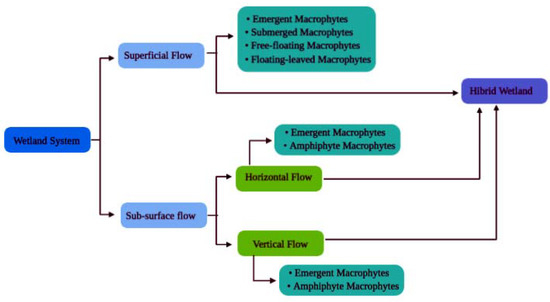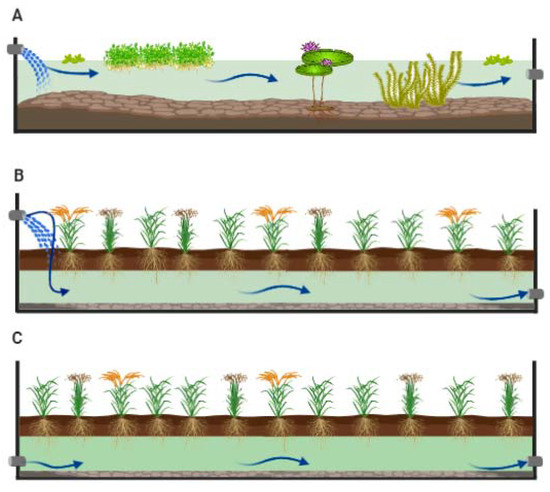
| Version | Summary | Created by | Modification | Content Size | Created at | Operation |
|---|---|---|---|---|---|---|
| 1 | Marcelo Pedrosa Gomes | + 1116 word(s) | 1116 | 2020-11-11 09:40:41 | | | |
| 2 | Vivi Li | + 8 word(s) | 1124 | 2020-11-17 03:32:38 | | |
Video Upload Options
We provide here an overview of the use and role of aquatic macrophytes in constructed wetland systems. The ability of plants to remove metals, pharmaceutical products, pesticides, cyanotoxins and nanoparticles in constructed wetlands were compared with the removal effciency of non-planted systems, aiming to evaluate the capacity of plants to increase the removal effciency of the systems. Moreover, this review also focuses on the management and destination of the biomass produced through natural processes of water filtration. The use of macrophytes in constructed wetlands represents a promising technology, mainly due to their effciency of removal and the cost advantages of their implantation. However, the choice of plant species composing constructed wetlands should not be only based on the plant removal capacity since the introduction of invasive species can become an ecological problem.
1. Natural and Constructed Wetlands
Wetlands include swamps, bogs, lakes, and the floodplains of rivers, and can be permanently wet or flooded only during certain periods [1]. Those wetland systems have enormous ecological importance, as they act as filters to prevent erosion, fix enormous quantities of carbon, and provide habitat and food resources for an enormous variety of organisms [2]. Natural wetlands are not recommended for removing water contaminants derived from anthropic activities, since those contaminants will interfere with ecosystem functioning. The solution, therefore, resides in the construction of new wetland systems [2]. Based on the observation of these natural systems the constructed wetlands were designed.
Wetland system technologies were originally developed in Germany in the 1970s, although many other countries have now demonstrated interest in them [3]. Wetland systems basically use plants to remove contaminants and treat residual waters [3], and they can also be used to control flooding, produce foods and fibers through aquiculture, and create habitats to compensate for natural areas converted for agricultural purposes and urbanization [4]. Different from natural wetlands, constructed wetlands have predetermined sizes, locations, types of substrate, hydraulic conditions, and controlled retention times [4]. Among the advantages of constructed wetlands are their low maintenance costs compared to other water treatment facilities, their use of renewable energy resources (solar and kinetic) and natural elements (microorganisms and plants) that do not depend on high technology, and their capacity to process large volumes of water containing different types of contaminants [4]. Additionally, those systems can serve as public visitation sites and for environmental education and research purposes [4]. The limitations of wetland systems include their sensitivity to high levels of ammonia, the necessity of occupying large land areas (their main disadvantage in relation to conventional systems) [5], uncertainties concerning their treatment efficiencies due to the interactions of various factors, and their potential for creating insect (mosquito) pests [6]. Moreover, constructed wetlands demand higher retention time than technical systems [5]. Research during the last 25 years, however, has demonstrated positive results in terms of wetland construction for treating domestic and municipal sewage, although their use for treating industrial residues is still challenging (due to their greater contaminant contents) [2].
The removal of contaminants in constructed wetland systems occurs mainly due to sedimentation and biodegradation processes [7]. Aquatic macrophytes provide structure for enhancing flocculation and sedimentation, and essential conditions for microbial activities to stabilization and degradation of contaminants [8]. Microbial biofilms are a group of microorganisms surrounded by a matrix of extracellular polysaccharides which remain adhered to any surface, for example, the contaminant and root surfaces (the rhizosphere) [9]. Thus, the efficiency of wetland constructed systems depends mainly on two factors: the tolerance of aquatic macrophytes to contaminants present in the environment [10] and the favoring of microorganism’s growth present in the rhizosphere [11].
In addition to aquatic macrophytes, microorganisms present in the rhizosphere of plants used in planted systems play important roles in the treatment, removal and degradation of contaminants [12]. For this reason, the study of microorganisms present in biofilm is fundamental for understanding the processes of treatment and stabilization of contaminants [13][14]. It is important to highlight, however, that different plant species may differently favor the growth and development of microorganisms due to differences on root exudates released, which determine the activity of the microorganisms [9][15]. In this context, in addition to their role in the uptake of contaminants, the chosen of correct plant species to constitute wetlands may increase the system efficiency due to their direct determination of biofilm development.
There are currently a number of different types of constructed wetland systems developed for specific purposes, as described below.
2. Types of Constructed Wetlands
Wetland systems can be characterized according to their hydrological processes, types of vegetation utilized, and flow directions [16], with two principal types: superficial flow and sub-surface flow (Figure 1).

Figure 1. Types of wetland systems (modified from Sehar and Nasser [17]).
Superficial Flow Systems (Figure 2A) are characterized by the use of floating, emergent, or submerged aquatic macrophytes to remove industrial, agricultural, or domestic contaminants; they are also indicated for treating lixiviates, residues in subterranean waters, and flow from mining operations [16][18]. Depending on the type of macrophyte chosen, a shallow layer of substrate (0.30–0.40 m deep) is necessary to fix the plants in a shallow basin system insulated below with appropriate material to prevent infiltration into the ground [2]. Water flow will then facilitate the processes of sedimentation, filtration, oxidation, reduction, adsorption, and precipitation, which allow residue treatment [18].

Figure 2. Illustrations of Wetland systems. Arrows indicate the direction of wastewater input and output flow. (A): Superficial wetland. (B): Vertical flow subsurface wetland. (C): Horizontal flow subsurface wetland.
Subsurface Flow Systems use emergent macrophytes fixed on permeable substrates (soil, rocks, or gravel) that allow water percolation; the substrate thickness is generally 0.6 m, with an impermeable insulating layer below [4]. According to Sehar and Nasser [16], the substrate layer of this system is efficient in filtering and removing contaminants, can function as a biofilm, and the substrate will accumulate trace elements, phosphorus, and other persistent substances. Subsurface systems can demonstrate both vertical and horizontal flow (Figure 2B and Figure 2C, respectively). Vertical flow systems require a smaller area for installation and have high purification performance from the beginning [5]. Moreover, this system provides good oxygen supply and nitrification and is of simple hydraulics. In contrast, vertical flow systems allow short flow distance but require higher technical skills [5]. Moreover, vertical flow systems do not favor the growth of denitrifying bacteria, thus limiting denitrification process [19]. In comparison to the horizontal flow systems, horizontal ones have longer life cycle, allow long flowing distance and both nitrification and denitrification are possible [5]. However, disadvantages of these systems are the complication of having equal waste water supply and the demand for careful calculation of hydraulics to optimize O2 supply [5]. The latter hybrid wetland type represents a combination of the systems described above to optimize contaminant removal [16]. In hybrid systems, the combination of vertical or horizontal flow systems, diminishes their individual disadvantages [20]. With all of the types described, experimental systems can be constructed at microcosmic of mesocosmic scales.
References
- Gopal, B. Natural and Constructed Wetlands for Wastewater Treatment: Potentials and Problems. Water Sci. Technol. 1994, 40, 27–35.
- Stefanakis, A.I. Introduction to Constructed Wetland Technology. In Constructed Wetlands for Industrial Wastewater Treatment; Wiley: Chichester, UK, 2018; pp. 1–21.
- Cole, S. The Emergence of Treatment Wetlands. Environ. Sci. Technol. 1998, 32, 218A–223A.
- Hua, S.C. The Use of Constructed Wetlands for Wastewater Treatment; Wetlands International—Asia Pacific: Selangor, Malaysia, 2003.
- Luederitz, V.; Eckert, E.; Lange-Weber, M.; Lange, A.; Gersberg, R.M. Nutrient Removal Efficiency and Resource Economics of Vertical Flow and Horizontal Flow Constructed Wetlands. Ecol. Eng. 2001, 18, 157–171.
- Nikolic, V.; Milicevic, D.; Milenkovic, S. Wetlands, Constructed Wetlands and Theirs Role in Wastewater Treatment with Principles and Examples of Using It in Serbia. Facta Univ. Ser. Archit. Civ. Eng. 2009, 7, 65–82.
- Ciria, M.P.; Solano, M.L.; Soriano, P. Role of Macrophyte Typha Latifolia in a Constructed Wetland for Wastewater Treatment and Assessment of Its Potential as a Biomass Fuel. Biosyst. Eng. 2005, 92, 535–544.
- Herath, I.; Vithanage, M. Phytoremediation in Constructed Wetlands. In Phytoremediation; Springer International Publishing: Cham, Switzerland, 2015; pp. 243–263.
- Pandey, J.; Chauhan, A.; Jain, R.K. Integrative Approaches for Assessing the Ecological Sustainability of in Situ Bioremediation. FEMS Microbiol. Rev. 2009, 33, 324–375.
- Rahman, K.Z.; Wiessner, A.; Kuschk, P.; van Afferden, M.; Mattusch, J.; Müller, R.A. Removal and Fate of Arsenic in the Rhizosphere of Juncus Effusus Treating Artificial Wastewater in Laboratory-Scale Constructed Wetlands. Ecol. Eng. 2014, 69, 93–105.
- Doty, S.L. Enhancing Phytoremediation through the Use of Transgenics and Endophytes. New Phytol. 2008, 179, 318–333.
- Ahn, C.; Gillevet, P.M.; Sikaroodi, M. Molecular Characterization of Microbial Communities in Treatment Microcosm Wetlands as Influenced by Macrophytes and Phosphorus Loading. Ecol. Indic. 2007, 7, 852–863.
- Fester, T.; Giebler, J.; Wick, L.Y.; Schlosser, D.; Kästner, M. Plant–Microbe Interactions as Drivers of Ecosystem Functions Relevant for the Biodegradation of Organic Contaminants. Curr. Opin. Biotechnol. 2014, 27, 168–175.
- Stout, L.; Nüsslein, K. Biotechnological Potential of Aquatic Plant–Microbe Interactions. Curr. Opin. Biotechnol. 2010, 21, 339–345.
- Prashar, P.; Kapoor, N.; Sachdeva, S. Rhizosphere: Its Structure, Bacterial Diversity and Significance. Rev. Environ. Sci. Bio/Technol. 2014, 13, 63–77.
- Sehar, S.; Nasser, H.A.A. Wastewater Treatment of Food Industries through Constructed Wetland: A Review. Int. J. Environ. Sci. Technol. 2019, 16, 6453–6472.
- Gomes, M.P.; Tavares, D.S.; Richardi, V.S.; Marques, R.Z.; Wistuba, N.; de Brito, J.C.M.; Soffiatti, P.; Sant’Anna-Santos, B.F.; da Silva, M.A.N.; Juneau, P. Enrofloxacin and Roundup® Interactive Effects on the Aquatic Macrophyte Elodea Canadensis Physiology. Environ. Pollut. 2019, 249, 453–462.
- Kadlec, R.H.; Wallace, S. Treatment Wetlands; CRC Press: Boca Raton, FL, USA, 2008.
- A Review of the Design and Performance of Vertical-Flow and Hybrid Reed Bed Treatment Systems. Water Sci. Technol. 1999, 40, 1–9.
- Gikas, G.D.; Tsihrintzis, V.A. Municipal Wastewater Treatment Using Constructed Wetlands. Water Util. J. 2014, 8, 57–65.




